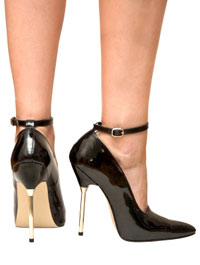Health Blog
The relationship between high-heeled shoes and bunions

Underlying causes of bunions not clearly established
A hallux valgus is a chronic condition characterized by a deformity of the big toe (metatarsophalangeal joint). When someone experiences hallux valgus, the big toe (hallux) begins to bend towards the small toes, eventually causing a bump to rise on the side of the foot known as a bunion. As the condition progresses and the bunion grows, pain and discomfort are experienced by the patient, which can be further aggravated by improper shoe wear. Hallux valgus occurs far more frequently in females and its occurrence rates vary depending on age, with some studies reporting it exists in anywhere from 28-33% of the population. One study reported that 65% of women between 40-69 in rural Korea suffer from it.
The specific causes of a hallux valgus and the accompanying bunion are not fully defined, though some attribute obesity, osteoarthritis, age or sex to be responsible. Another possible cause is high-heel usage, since they put excessive force on the feet and ankles. To test this theory, a study was conducted that investigated how often hallux valgus occurs in Chinese women and the relationship to high-heeled shoes in.
Massive sample size provides adequate information
Questionnaires requesting information about demographics, high-heel shoe habit, family history and foot-related pain were dispersed to multiple communities throughout Hong Kong. A total of 1,080 females between the ages of 18-65 responded, and 24 cases were dropped due to incomplete information, leaving a sample size of 1,056. Each respondent was asked to complete the questionnaire and rate her foot condition using a series of photos illustrating various stages of hallux valgus and the bunions that accompanied them. Data was then analyzed to determine what role high-heeled shoes, family history and other factors had on the occurrence of hallux valgus.
High-heeled shoes don't predict hallux valgus, but family history does
Of the 1,056 subjects, 385 (36.5%) indicated having various degrees of hallux valgus, with 312 (29.5%) reporting it as a mild condition, 50 (4.8%) reporting it as moderate, and 24 (2.2%) reporting it as severe. Respondents over the age of 40 also reported a higher prevalence of hallux valgus than their young counterparts.
In regards to high-heeled shoes, 226 (21.4%) of subjects claimed that they wore them all the time, while 453 (42.9%) reported that they wore them sometimes, leaving 377 (35.7%) that never wore them. A total of 88.8% of subjects with hallux valgus reported that other members of their family also had the condition in some form. Based off that same figure, it was shown that 73.2% had a family history of hallux valgus but did not wear high heels. Furthermore, of those without a family history who often wore high heels, hallux valgus was only found in 2.8% of cases.
Family History an Excellent Indicator
It was then deduced from the information noted above that subjects with a family history would be 26 times more likely than those without one who often wore high heels to develop hallux valgus.
While high heels are believed by some to be a main culprit in the development of hallux valgus/bunions due to the increased pressure they put on the foot, this study did not provide any information to support that claim. The fact that nearly 90% of subjects with hallux valgus also had a family history of the condition shows that variable to be a much more likely predictor than high heel usage. With only 2.8% of subjects with no family history who often wore high heels suffering from hallux valgus, and 73.2% of subjects with family history who did not wear high heels, it appears that according to these figures, it seems clear that high heel usage plays a minor and insignificant role in the development of hallux valgus. This is not to say high heels are an ideal or even healthy choice for female footwear-since they do place unnecessary stress on feet and can be harmful-but it should be noted that family history, not high heel usage, should be a major concern in predicting the development of hallux valgus.
-As reported in the May '10 edition of Foot and Ankle Online Journal
December 19, 2010
Back to Health BlogHEALTH BLOG
- A Personalized Physical Therapy Program Can Assist with Whiplash
- Why Older Adults Should Incorporate an Exercise Program
- After an Achilles Injury, Physical Therapists Can Help with Recovery
- AI Can Answer Questions But It’s Best to See a Physical Therapist
- Physical Therapy Can Help With Symptoms of Wryneck
- Reduce the Risk of Pickleball Fractures By Taking Proper Precautions
- Physical Activity May Slow the Progression of Parkinson's Disease
- Too Much Salt in Your Diet? Learn the Dangers of High Sodium Intake
- Suffer From Lower Back Pain? Might Be Time to Take A Break
- The Road to Recovery: Preventing Re-Injury After ACL Surgery
RECENT ARTICLES

- 11 Possible Reasons Your Back HurtsJune 22, 2020

- What Conditions Can a Chiropractor Treat?May 25, 2020

- A Simple Guide to Better PostureApril 30, 2020

- Is Acupuncture Right for Me When I’m Afraid of Needles?March 30, 2020

- Stretching Done Right — How and When to StretchFebruary 26, 2020

